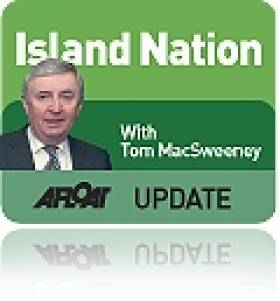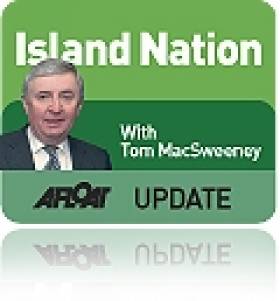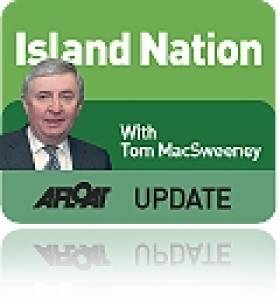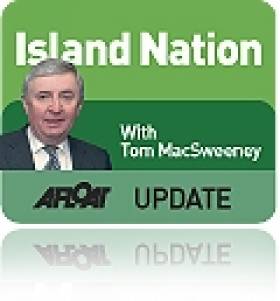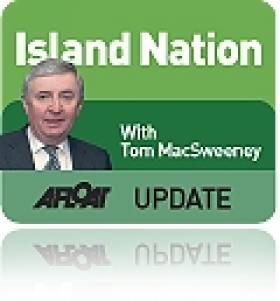Displaying items by tag: Tom MacSweeney
Naming a Lifeboat in Kilrush
I have been at many naming and launching ceremonies but never before had the honour of being invited to perform a naming ceremony. The spirit of friendship, of commitment to helping others, which is the hallmark of the RNLI, made it a very pleasant occasion.
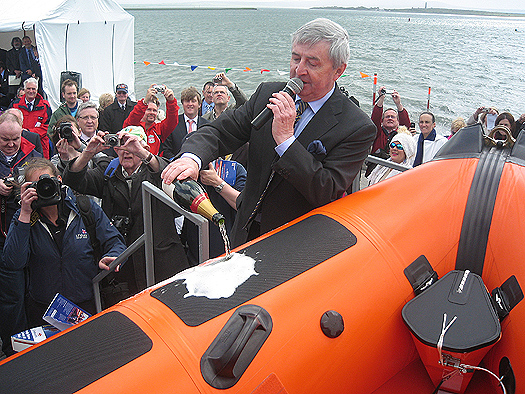
Kilrush has a strong maritime tradition, Steamers operated from there in the 19th century, towing lighters carrying cattle and other goods upriver to Limerick. A fleet of sailing boats, known as turf barges also carried various goods and vast amounts of turf to the Treaty City. Cappa, nearby, provided the pilot station for vessels entering the Shannon Estuary from the sea. The Royal Western Yacht Club was established in Kilrush in 1828.
The town is the base of the Irish Whale and Dolphin Group. Whale and dolphin watching is one of the boating attractions of Kilrush.
In recent years a marina built at Kilrush caused major controversy when it over-ran its budget.
"The manner in which the marina project was carried out may have justified criticism, but there was a predictability about it, coming from the national media, from political circles, from urbanites in Dublin and elsewhere who have no understanding of coastal areas," one of the men who campaigned for and defended the marina project, told me. "There are people who don't want the coastal areas to be better than urban centres, who don't want the rural areas to be more attractive than the urban jungles. There are benefits from maritime development, the marina is justifying itself, the yacht club has been revived, young people are taking up water sports, the leisure sector brings money into the town, the boat trips attract tourists."
Kilrush lifeboat station was established in 1996 to provide additional cover on the west coast, particularly on the Shannon Estuary. The boathouse and launching slipway were built facing Scattery Island, with access to the deepwater channel, providing housing for the lifeboat and launching vehicle, a workshop, fuel store and crew facilities.
The new boat is named Edith Louise Eastwick, in memory of the mother of the late Baroness Marjorie Von Schlippenbach. It was built at a cost of €185,000 and has a number of improvements from the Atlantic 75, Kilrush's former lifeboat, including a faster top speed of 35 knots, radar, provision for a fourth crew member and more space for survivors. It can operate safely in daylight in up to force seven conditions and at night up to force six. There is no greater gift that anybody can give than that of saving life.
I was told once by a lifeboat man that the gift they get is to see somebody safely ashore after they have rescued them. Isn't it the greatest gift lifeboat people give, saving someone else's life?
Cheeky Chinese Challenge?
This is an interesting challenge to the present US holders, computer software billionaire Larry Ellison's Oracle Racing team which decided to have the event hosted by the San Francisco Yacht Club, which prides itself as being "the oldest club West of the Mississippi in North America."
It will be the first time the America's Cup has been hosted in the United States since 1995 and it is interesting to speculate whether the Chinese are cheekily challenging the Americans who don't like the Cup going outside of the States.
Racing will be held on the iconic San Francisco City front and be visible from world-renowned tourist destinations such as the Golden Gate Bridge.
"My support for San Francisco hosting the America's Cup goes beyond the opportunity to see our team competing on home waters," said Russell Coutts, CEO, ORACLE Racing. "We are excited to sail for our sport's greatest trophy, on a stretch of water legendary among sailors worldwide."
The China Team has been given the backing of the Chinese Government and has already been designing a boat for the 34th Cup event which will be raced in 72-foot wing-powered catamaran multihulls.
"We have been working with some of the best worldwide designers for hulls and wings for a few months in partnership with top Chinese universities," the Team Leader, Wang Chao Yong, said. "This is an opportunity to showcase Chinese talents at the leading edge in hi-tech areas of both hydrodynamics and aeronautics. Our boat will be built in China."
The Chinese made an unsuccessful attempt on the 2007 America's Cup. While the intention is that most of the sailors on their America's Cup team will be Chinese there is to be, as in the 2007 attempt, a French influence. Thierry Barto has been appointed Chief Executive Officer and given the task of getting top sailors to coach the Chinese team.
It seemed initially that interest might be lacking in the 162-year-old event. However ten teams have signed up to take part in the 34th America's Cup.
Aside from the defender, Oracle, entries include Team New Zealand, Italian syndicate Mascalzone Latino - the official challenger of record - and Artemis of Sweden. Two French teams and the Chinese have also paid their entry fees. America's Cup Racing Management says two other unidentified teams, one of which is believed to be Italy's Venezia Challenge, will take part. Whether all of the existing entries make it to the start line of the challenger elimination series in July of 2013 will be interesting. There was major legal action before the event was re-scheduled for 2013. Oracle and Ellison declared their preference for a defence in San Francisco as the "home club".
Two of the three possible French challengers had talks with the Minister for Sport in Paris last Friday to discuss amalgamation and whether there would be French government support. There is also an "Argo Challenge" from a group of disabled sailors.
• This article is reprinted by permission of the EVENING ECHO newspaper, Cork, where Tom MacSweeney writes maritime columns twice weekly. Evening Echo website: www.eecho.ie
Conference Hopes to Bin Ocean Debris
It was very topical, because this week the Fifth International Marine Debris Conference is taking place in Hawaii, organised jointly by the National Oceanic and Atmospheric Administration and the United Nations Environment Programme. This is an attempt to deal with the increasing problem of debris in the oceans of the world.
A United Nations report revealed some pretty frightening facts to the conference. Just two kinds of rubbish make up more than half the marine debris in the world. One is predictable enough – the horror of plastic choking sea life. The other came as more of a shock. The second most abundant kind of marine litter is smoking-related. Cigarette butts and packing account for nearly half of all sea rubbish in some parts of the world, according to the UN.
About 40 per cent of the litter in the Mediterranean Sea comes from this source. In Ecuador, smoking-related refuse accounted for more than half of coastal rubbish.
Ocean debris is a severe threat to the marine eco system. It kills at least 1 million sea birds and 100, 000 mammals each year, according to the United States National Oceanic and Atmospheric Association. The general prognosis at the conference in Hawaii has been pretty grim. Things are getting worse and it is the fault of humans on land using the oceans as rubbish dumps.
As my grandson's homework showed, it takes two weeks for a bit of fruit thrown into a river or the sea to bio-degrade. It will be two months before a piece of cardboard breaks down, three months for a milk carton and matters get worse where a cigarette butt is concerned. That will take ten years to disintegrate, a Styrofoam coffee cup 50 years, a plastic bag over a hundred and the six-pack ring so often tossed overboard from boats 400 years, with the plastic bottle even worse at 450 years.
The threat and impact of marine debris have long been ignored. Perhaps it is the perceived vastness of the ocean and lack of visibility of marine debris, but the teachers in Crosshaven national school, on the edge of Cork Harbour deserve praise for making their young pupils aware of what throwing litter into a river or dumping it on a beach does.
• This article is reprinted by permission of the EVENING ECHO newspaper, Cork, where Tom MacSweeney writes maritime columns twice weekly. Evening Echo website: www.eecho.ie
Marine is Back
It is a reminder which I hope that the media in general will note and that his tile of Marine will be used as often as agriculture is. The general media has been notorious, in my view, for disregarding the marine sector unless there is disaster, emergency or controversy involved.
The return of the title 'Marine' to a Government Department is, to put it bluntly, a kick-in-the-ass which civil servants needed. It was a betrayal of this island nation's heritage when those in charge of the former Department of Transport held a meeting which decided to remove the title marine from the Department's name, even though the then Minister had been assigned the role of Minister for Transport and Marine. The man in charge of that Department, Noel Dempsey, did not demonstrate a lot of interest in the marine, being more noted for trying to shut down the coastal radio stations at Valentia and Malin, where he was beaten off by public opposition, which also happened when he tried to remove 24-hour rescue helicopter service in the south-east and for his introduction of laws which criminalised fishermen.
Hopefully, the restoration of 'Marine' to a Department's name will be the harbinger of better things for the marine sphere.
I have heard some disappointment expressed that the marine is not a department on its own, but what the Fine Gael and subsequently Coalition Programme for Government agreed by Enda Kenny and Eamon Gilmore said was: "Marine responsibilities will be merged under one Department, for better co-ordination in policy delivery."
They have been, though some of the finer detail remains to be seen, such as will the ports be moved away from Transport, to where port companies and commercial interests originally campaigned to have them moved? And how will the split of marine tourism work between Agriculture and Marine and the separate tourism department? A similar issue may arise in regard to sailing and sport, but it seems to me a positive step that the disregard which Fianna Fáil and the Greens showed for the marine sector is being changed.
It was also right to end a separate department for defence. With a small army and navy, smaller than the marine sector, it was nonsense that it should have been a department of its own.
Let us therefore, hope for the future and take a positive view of the change as being for the better.
Will Election Promises Be Delivered On?
Fine Gael can, logically from the support which the party garnered in the General Election, be expected to dominate a Coalition Government. In that context, the question arises as to whether they will deliver on their pre-election manifesto commitment to re-establish the Department of the Marine?
The promise to do so was unequivocal, a clear undertaking that the situation created by the former Fianna Fail and Green Party Coalition which had decimated maritime issues by spreading them over several Departments of State, would be changed and all would be contained in one Department.
In the event of a Coalition being formed will we hear that "circumstances" have changed and adjustments must be made in the context of Coalition arrangements?
I had the opportunity to question Joan Burton of the Labour Party, one of the party negotiators, prior to the election at an event organised by the European Association of Journalists. She accepted that politicians had not paid enough attention to the marine sphere and said that this attitude should be changed and accepted that the nation could benefit economically as a result.
I hope that I am not being overly cynical towards politicians, born of long years of journalistic experience, in fearing that pre-election promises may be subjected to change.
• This article is reprinted by permission of the EVENING ECHO newspaper, Cork, where Tom MacSweeney writes maritime columns twice weekly. Evening Echo website: www.eecho.ieAfloat's March/April Issue Out Next Week!
Is there no end to the achievements of Irish boaters against seemingly impossible odds?
The winter may have been a time of hibernation for some of us but as the stories in Afloat's March/April issue will bear out Irish sailors have been battling the elements all winter long.
James Carroll competed in January's Sydney-Hobart offshore race and, much closer to home, Paul A. Kay journeyed through snow and ice in December from Dun Laoghaire to a new marina on Valentia Island.
As if to prove a point that we're down but not out, a winter of results on foreign waters includes a win in the Mirror World Championships in Australia and a top Olympic result in Florida, USA.
They are gutsy performances from youth teams that shows, if nothing else, the next generation of Irish sailors is really up for a fight. All this plus lots, lots more on news-stands next week!
Selected contents from Ireland's only boating magazine include:
News
Surveyors Issue Boat Launch Warning, Buoyant Dinghies Buck the Market, Ice Diving in Ireland, German U-Boat Rediscovered in Cork Harbour, an Historic Trophy for South Pacific Dream Cruise, MGM open in Cork, Hugh Mockler joins Crosshaven Boatyard plus lots, lots more.
News Focus
A new masterplan for Dun Laoghaire harbour is badly needed but it needs buy in from all those that use it
Going Offshore
The tenth Dun Laoghaire to Dingle offshore race was launched in style
Marine Conference
Combating the downturn was the focus of a unique marine gathering on both sides of the Irish sea.

Gear Review
New dinghy gear, a new Crosshaven boot from Dubarry, a new raincoat for girls and an upgrade for Musto's MPX.

This Island Nation
The decision to shut down the fog signals was based on a detailed risk assessment. Tom MacSweeney on the loss of fog horns
Sailor of the Year
Anthony O'Leary of Cork is the Afloat.ie/Irish Independent "Sailor of the Year" in celebration of his outstanding achievements afloat nationally and internationally.
Tall Ships
W M Nixon looks at the realities of national sail training in the 21st Century.
Tall Ship Conference
Ireland could yet have a tall ship to replace the Asgard II and the Lord Rank, if a new group formed to press for a replacement is successful
Racing update
Ulstermen's World Title, Topper worlds for Dun Laoghaire, Two Irish campaigns line up for Figaro Race, SB3 Sailors Cry Foul at Dun Laoghaire Parking Fees and an Irish entry in the Moth worlds in Australia, Irish Mini 6.50 Campaign in Prospect.

Youth Worlds preview
Results achieved abroad this Winter are the backbone for further Irish youth
success

Figaro Preview
Two fledgling Irish La Solitaire du Figaro campaigns edged closer to the start line last month
Volvo Dun Laoghaire Regatta
Volvo Dun Laoghaire regatta has taken in 22 entries six months ahead of the first race of the biggest regatta in Irish sailing.

Fireball Worlds preview
Dun Laoghaire's Noel Butler intends to continue his winning run in the Fireball class this season but the year ahead doesn't look so easy as the World Championships come to Sligo
Sovereigns cup preview
Up to 30 Quarter tonners will be at the Sovereigns Cup this year including one from New Zealand.
Shiver to deliver
A journey through snow and ice from Dun Laoghaire to Valentia Island
Sydney-Hobart Race
Outside of the Volvo Ocean Race, the Sydney Hobart is one of the world's most challenging offshore races. James Carroll Raced it in January.
Inland
As the cuts begin to bite, it may be time to look at the British direction for our waterways, writes Brian J Goggin
Dubarry Nautical Crossword
Soundings
A Google aerial photo proves useful navigating for Baldoyle Estuary
- Anthony O'Leary
- Dun Laoghaire
- Tom MacSweeney
- Harbour
- MGM Boats
- Asgard II
- World Championships
- Dinghies
- Olympic
- Cork Harbour
- Valentia
- Mirror
- Dingle
- youth
- Lord Rank
- Island Nation
- Hugh Mockler
- Dubarry
- Tall ship
- brokerage
- sydneyhobart
- fog horn
- moth
- Mini 6.50
- Uboat
- Fireball worlds
- Sovereigns
- James Carroll
- Paul A. Kay
- Crosshaven Boatyard
- Baldoyle
- MPX
- W M Nixon
Marine Department Promised, First America's Cup Capsize, Whales and Sailing Oil Tankers
I am reflecting this week on a varied list of maritime issues which have arisen in my writings on marine topics.
Following recent pieces I wrote about the attitude of political parties in the General Election towards the marine sector, I had a telephone call from a senior Fine Gael politician and, lo and behold, the party included the marine sector in its manifesto, pledging to restore the Department of the Marine, abolished by Fianna Fail. I await post-election developments with interest.
It has been a good week for those interested in protection of whales and dolphins. Hundreds of dolphins were spotted off the Old Head of Kinsale, apparently following shoals of herring and sprat on which they were feeding.
In the Antarctic the Japanese whaling fleet was forced to give in to pressure to stop culling. The Japanese have killed hundreds of whales every year, claiming this was for "scientific purposes," even though it has been identified worldwide as for human consumption. The fleet was ordered home by its Government after increasing international pressure.
The Irish Whale and Dolphin Group published its annual report this week. It was formed in December 1990, dedicated to the "conservation and better understanding" of cetaceans - whales, dolphins and porpoise - in Irish waters through "study, education and interpretation." IWDG turnover in 2010 was around €300,000. It has dealt with up to 10,000 queries a month for information on its website. A total of 92 strandings of 128 individual cetaceans was reported to the IWDG in 2010. This compares to 137 strandings of 169 animals for 2009.
This week oil prices rose because of the unrest in Libya and David Surplus, Chairman of B9 Energy Britain's largest windfarm operator, warned that sooner or later oil will run out. BP is examining the possibility of building a fleet of carbon-neutral, wind-powered sail ships planned, to carry world trade.
On the international sailing scene the new AC 45, forerunner of the next generation of America's Cup boats was launched in New Zealand and had its first capsize. The wing-sailed catamaran is designed for speed and close racing, capable of making up to 30 knots, while intended to be handled in tight, tactical courses. An exciting boat to sail, it will also be very testing of ability. The first capsize of the new boat occurred on Auckland's Hauraki Gulf, hit by what was described as "a freak gust of wind," while the crew were doing maintenance on board before a sailing test.

Back in dock after the capsize
It capsized fully, ending upside down. Three support vessels were needed to pick up the crew and right the boat which was sailed back to its base in Auckland. There was damage to the wing sail, but no injuries to the crew. However, helmets may be an additional precaution needed for sailing these boats, which are to be used in the AC World Series! This will be a circuit of eight regattas for which venue bids are being made at present, with fleet and match racing, to raise the profile of high-performance sailing on worldwide television. Racing is to start in July, with regattas running until May of next year, leading into preparations for the next full AC series in the bigger AC72 catamarans in 2013 in San Francisco.
As the past week showed, there is always something interesting in the sea.
This article is reprinted by permission of the EVENING ECHO newspaper, Cork, where Tom MacSweeney writes maritime columns twice weekly. Evening Echo website: www.eecho.ie
Now There is None
What a magnificent sight it was as the three Tall Ships, each flying the Tricolour, headed the fleet of the gracious ships of sail from all over the world.
How different it will be in July when the world's Tall Ships again parade down the Suir. There will be no Irish national sailing ship to lead the parade. A number of private Irish entries are expected at Waterford from June 30–July 3 amongst the 70 vessels from around the world when the city has the honour starting the race. In 2005 about half-a-million people visited the city while the Tall Ships were there.
The lack of a national tall ship is another example of governmental maritime neglect, directly due to the decision of former Defence Minister Willie O'Dea, T.D. After the sinking of ASGARD he publicly committed the Government to its replacement, but after receiving insurance compensation money for its loss, he put the money into coffers of the Department of Finance and closed down the national sail training programme. There was a big difference between what he promised and what he did, a disregard for the maritime sphere which it is hard to forgive. I also recall how former Taoiseach Bertie Ahern did not visit Waterford during the 2005 race, when it was the biggest tourist event in the country. When I broadcast my report expressing astonishment at this snub government sources and Fianna Fail didn't like it. Truth in the news can be painful!
The organisers made contacts about the DUNBRODY, which continues to earn income at the New Ross quayside where it is moored as a tourist attraction and with the JEANIE JOHNSTON, moored at the Dublin Docklands.
However, neither will be taking part, the organisers have confirmed, tough they said that it was expected that about 100 young Irish trainees would sail aboard tall ships in the race, half of them with funding support from local authority, business and other sources. A group of Irish sailors have also indicated they are making arrangements to charter a UK-registered vessel the JOHANNA LUCRETIA for the event.
Once again the Irish Government has sunk to the bottom where maritime matters are concerned.
It was announced this week in Waterford that Fáilte Ireland has made a significant financial and marketing commitment to this year's event, though the financial figure was not disclosed .A free festival programme will feature street acts; comedy; international and home-grown artists, nightly fireworks, an artisan food village and an atmosphere which the organisers say "will thrill people of all ages and nationalities."
• This article is reprinted by permission of the EVENING ECHO newspaper, Cork, where Tom MacSweeney writes maritime columns twice weekly. Evening Echo website: www.eecho.ie
Lifejackets and Many Kinds of Racing
The wearing of jackets is not compulsory, but a decision for the individual sailor, though Skipper can insist that crews use them while racing.
In the United States a debate is underway as to whether the wearing of jackets at all times on racing boats should be made compulsory by law. Regulations here require that everyone on board any boat of seven metres or less, approximately 22 feet, must wear lifejackets. They must be carried aboard for everyone on any vessel regardless of size. Every child less than 16 years of age must wear a lifejacket or personal floatation device at all times on deck while the craft is underway.
As owners prepare boats for racing this season, these regulations should be kept in mind. Enforcing the law, or even effectively checking its application remains patchy. Introducing laws is easier than implementing them, particularly in a yacht racing situation. Sailing clubs have their own enforcement arrangements and insist on buoyancy aids for dinghy racing.
Safety on the water is an issue for each individual, but skippers/owners would be well advised to protect themselves in this litigious nation by insisting on the wearing of lifejackets by crew members during racing. Accidents will happen. Preparation is best.
The national sailing association, the ISA, is to nominate teams for this year's Nations Cup match racing. The finals will be held at the USA Sailing Centre in Wisconsin from September 13-18.
The Irish Sailing Association this week sought expressions of interest from skippers who would like to represent Ireland, in the first instance at the European Regional Finals in Gydnia, Poland, from July 19-23.
Ireland is drawn in Europe Group II in the open and women's classes. Expressions of interest are needed to the ISA by next Tuesday, February 8. Selection will be based on performance in the ISA Match Race Championships last year and ISAF ranking positions.
2-handed class" racing in this year's Dun Laoghaire Week in early July. A number of skippers have already expressed interest and there may be UK boats. He wants to know if any South Coast sailors are interested. Contact Olivier who is Sailing Manager at the National Yacht Club in Dun Laoghaire, phones 012801198 or 2805725 or by Email to Olivier at: [email protected]
Vinnie O'Shea of the RCYC has been elected Commodore of the South Coast Offshore Racing Association (SCORA). Jackie Kenefick of Schull Harbour SC is Executive Officer and Michael Murphy of both the Schull and Crosshaven clubs remains as Treasurer and PRO. The Association is to discuss class bands and handicapping.
This article is reprinted by permission of the EVENING ECHO newspaper, Cork, where Tom MacSweeney writes maritime columns twice weekly. Evening Echo website: www.eecho.ie
More on lifejackets
http://www.afloat.ie/safety/lifeboats/item/13619-majority-of-lifejackets-fail-lifeboat-test/
Going it Alone – or Short-Handed!
In the late 1970s he wanted to develop a "relatively affordable" solo offshore race in contrast to the trend towards bigger and more expensive boats in other trans-ocean races, such as the OSTAR.
With its strong maritime tradition it was appropriate that Plymouth should be at the forefront of the initiative. It was from there in 1620 that the Pilgrim Fathers sailed for the New World and established settlements in what became the USA. And it was on Plymouth Hoe that Sir Francis Drake is said to have played a game of bowls before setting off to engage the Spanish Armada in battle in 1588.
From Bob Salmon's initiative the Mini Transat was developed, the yachts limited to 21-feet maximum.
It is the smallest Open Class trans-ocean race and has been a breeding ground for professional ocean racers. There is now a move to get Ireland involved. This reflects the growing interest in short-handed sailing here despite the attitude of the Government which has rules in place that are regarded as discouraging this type of racing.
The Irish Double and Solo Racing Group was launched last year to develop a vibrant community of Irish solo and double-handed sailors as well as establishing a regular sailing calendar here.
In the past two years Irish sailors achieved remarkable success in short-handed ocean racing. Damian Foxall won the double handed Barcelona World Race with French co-skipper Jean Pierre-Dick on their Open 60 PAPREC-VIRBAC. Cobh man Barry Hurley won his class and finished 4th overall in the OSTAR (Original Single-handed Transatlantic Race) in his JOD 35 DINAH. Besides these victories there has been a large increase in the number of Irish sailors participating in solo and double-handed sailing. Several are travelling to events in the UK and France where this type of sailing is firmly established.
Now Michael McKeon a member of the Double and Solo Group is the man spearheading interest in the Transat here.
He has 30 years' sailing experience and, following the success of a series of "Mini open days" which he ran in Dublin aboard his own boat, HYPOMENE, Michael wants to rally "interested parties" to help campaign it as the 'Irish Mini' during the 2011 season and create the Mini Transat Class in Ireland.
"The sailing level is from pure amateur up to professional," he says. "The Mini gathers an average of 500 subscribers, most of them competitors coming from all kind of professions, from the carpenter to the engineer, the nurse to the steward, the journalist to the professional skipper. Anyone interested in the Mini 6.50 class and in sampling short-handed racing the 'French way' is welcome."
More information is available from Michael at: Email: [email protected] or Mobile 086-8494924
• This article is reprinted by permission of the EVENING ECHO newspaper, Cork, where Tom MacSweeney writes maritime columns twice weekly. Evening Echo website: www.eecho.ie
Check out our Solo sailing stories here



























